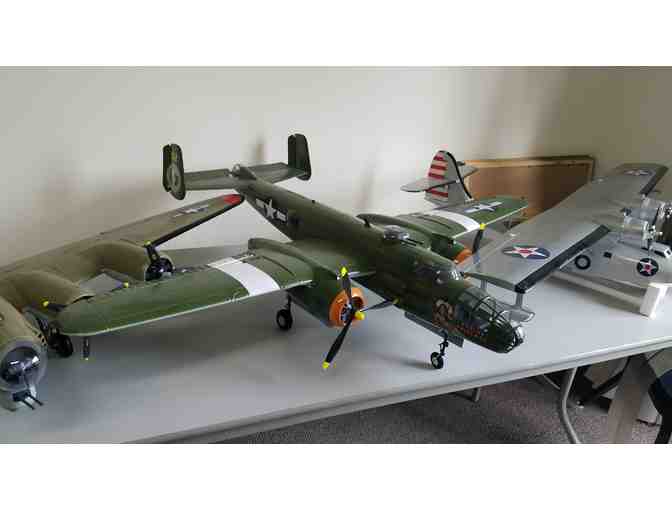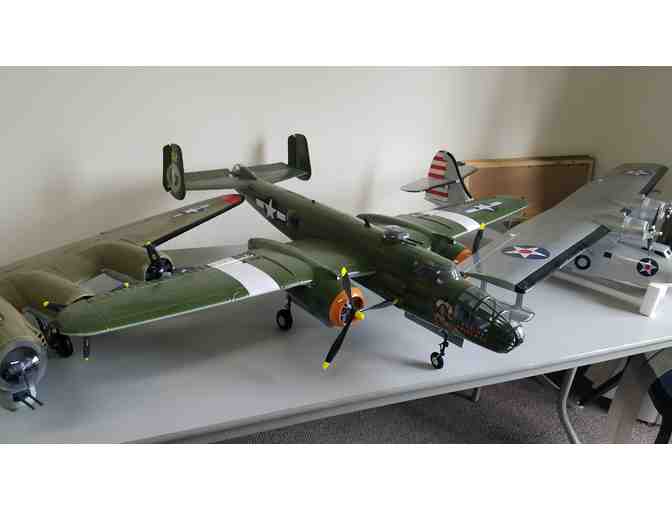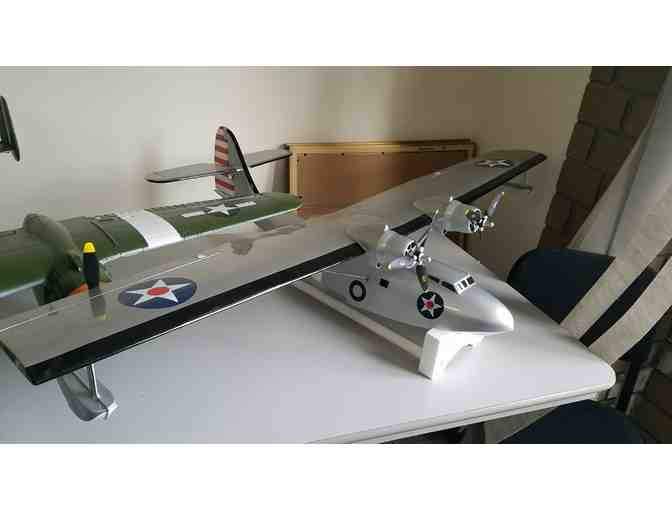Entertainment & Fun
3 RC Model Planes
- Item Number
- 106
- Estimated Value
- 1130 USD
- Sold
- 600 USD to GoCats85_19
- Number of Bids
- 3 - Bid History
Item Description
3 working Model planes.
All three planes are electric powered.
Motors and speed controllers are installed in all three planes.
Both bombers have electric powered retractable landing gear, the 4 engined one has built in shock absorbers.
They all need lithium-ploy (lipo) batteries, voltage and capacities are specified in the instructions manuals provided.
Radio Controllers and battery not included.
North American B-25J Medium Bomber:
Built by North American Aviation, the B-25 Mitchell Medium Bomber first flown in early 1939 was in response the the US Army Air Corp circular issued in March 1938 outlining the performance requirements required in the next generation of bombers: range of 1,200 miles at speeds in excess of 200 miles per hour, and a payload of 1,200 pounds.
The B-25 was named in honor of, the Pioneer of Military Aviation, Major General Billy MItchell, and would see combat in the following Theaters of Operation: Asia, South Pacific, Middle East, Italy, and Europe. During WW II, the Mitchell would serve with aviation units of the countries of the United States of America, United Kingdom, Soviet Union, Denmark and the Netherlands, Canada, and the Republic of China.
The “J” variant of the B-25 was the last factory series production of this medium bomber came with a transparent nose but could be adapted to accept the solid nose strafing variant found in the earlier “H” model.
Boeing B-17G Flying Fortress:
The B-17 Flying Fortress began developed in 1934 in response to a US requirement for a long-range, four engine bomber, capable of carrying up to a 2,000 pound bomb-load.
Built by Boeing Aircraft Company (12,731 aircraft produced), the B-17 Flying Fortress in its different variants became the mainstay US heavy bomber in both the European and Pacific theaters. By the end of World War II, the B-17s had flown over 290,000 sorties and dropped over 640,000 tons of bombs. The B-17s had also seen service flying in the air forces of the United States of America, United Kingdom, Canada, Denmark, South Africa, and at least 10 other countries.
The B-17G was the final major variant of this bomber developed during WW II, armed with 13 50 caliber machine-guns, it is easily recognizable by the powered chin turret under its nose. As the final version of the Flying Fortress, the “G” model incorporated all the changes made to its predecessor the B-17F and 8,690 “G” models would eventually be built.
Consolidated PBY-5A Catalina Flying Boat:
One of the most recognized aircraft in the world, the Consolidated PBY Catalina not only served in the U.S. Navy, but also with the air arms of Britain, Australia, New Zealand, Canada, the Netherlands and the Soviet Union. The PBY was involved in almost every major operation in World War II, and figured significantly in defeating the U-boat menace in the Atlantic.
In response to an October 1933 order from the Navy for a monoplane patrol aircraft, Isaac Laddon of Consolidated Aircraft designed the all metal Model 28 with a number of unique features, including a parasol-mounted wing incorporating internal bracing to reduce the need for external struts, and retractable stabilizing floats that folded upward to become wingtips in flight.
The overall effect was an aerodynamically clean aircraft far superior to previous flying boat designs. Powered by two Pratt & Whitney R-1830-58 engines of 825 horsepower each, the aircraft, with a crew of seven to ten, was armed with three 0.30-in. machine guns, and could carry 2,000 lb. of bombs. Designated the XP3Y-1, the aircraft made its first flight on 15 March 1935. Early trials proved quite successful and the Navy ordered 60 of the aircraft in June 1935. Because it could carry a substantial bomb load, the aircraft was redesignated a patrol bomber. Fitted with more powerful R-1830-64 engines and incorporating modifications to the fin and rudder, the XPBY-1 was delivered to Patrol Squadron (VP) 11F in October 1936.
Improved PBY-2, PBY-3 and PBY-4 models appeared between 1936 and 1939, each incorporating updated R-1830 engines and other minor modifications. The PBY-5 was introduced in September 1940, just in time to take part in the Neutrality Patrol in the Western Atlantic. By the end of 1941, the Navy had 16 squadrons operating PBY-5s. At the same time, Consolidated introduced the amphibious PBY-5A. By then, the name Catalina, originated by the RAF, was adopted.
Production of the aircraft took place in Buffalo, San Diego and New Orleans. Boeing of Canada built 362 PBYs, and Vickers of Canada produced another 240 Catalinas and similar Cansos, the latter destined for service with the RAF, RCAF, RAAF and RNZAF. The New Orleans factory, besides providing aircraft for the Navy, also provided 75 aircraft to the USAAF and 48 to Russia. Coast Guard service commenced in 1940.
Later models equipped with radar and Magnetic Anomaly Detection (MAD) equipment operated throughout the Atlantic, Mediterranean and Pacific. Not only did the Catalina figure significantly in disrupting U-boat operations, it also proved ideal in long-range reconnaissance (PBYs located the Japanese fleet at Midway), night anti-shipping (Black Cats) and air-sea rescue (Dumbo). The venerable Catalina served in every theater of the war. In all, 3,276 PBYs were built.
Donated By:
VIctor Dea
St. Ignatius College Prep stores data...
Your support matters, so St. Ignatius College Prep would like to use your information to keep in touch about things that may matter to you. If you choose to hear from St. Ignatius College Prep, we may contact you in the future about our ongoing efforts.
Your privacy is important to us, so St. Ignatius College Prep will keep your personal data secure and St. Ignatius College Prep will not use it for marketing communications which you have not agreed to receive. At any time, you may withdraw consent by emailing Privacy@frontstream.com or by contacting our Privacy Officer. Please see our Privacy Policy found here PrivacyPolicy.




